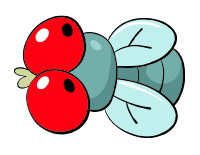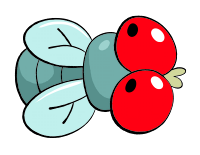FRIDAY THE 30th, NOVEMBER 2018:
BEE FLIES

Source
A couple of years ago, several photographs of today's flies went viral around the internet as "the world's cutest insects," and they even made it into Pokemon not long after, as a bug/fairy type under the name cutiefly. In fact, the common name of this particular species in japan is basically just "cute bee," but of course, this isn't a bee at all - it's a bee fly, a member of the Bombyliidae!

Pdeley
Though their fame spread outwards from Japan, Bombyliids are actually found all over the world, and while many species follow a similar body plan of rounded, fluffy body and long, needle-like proboscis, others are difficult to distinguish from a variety of other Diptera, like this beautiful Hyperalonia morio. All known species feed from flowers in their adult stage, and those with the longer mouth parts are able to feed while "hovering," like a hummingbird. Unlike most flower-loving flies, however, Bombyliids will consume both nectar and a little pollen, which gives a nice boost to their protein intake.

Pdeley
Those species that do resemble bees even hover in a similar flight pattern to the Hymenopterans, and as with many bee mimics, it serves as defensive mimicry. Not even all actual bees have stingers, but a predator can never be quite sure, and that's good enough to give these flies at least a little edge. Despite having no physical defense mechanism, however, these flower sippers are far from "harmless."
In this rare footage, a female bee fly has followed the scent of a real bee, a solitary species that builds its nest in sandy soil. With pinpoint accuracy, she positions herself in mid-air above the entrance to the bee's home, and repeatedly "flicks" her abdomen over the hole. You can't see it with the naked eye, but every single flick is dropping one of her own eggs into the other insect's nest.

Beetles in the Bush
What "cutest insect ever" posts don't always feel like sharing (or perhaps never bothered to research at all) is that the entire Bombyliidae are brood parasitoids, meaning that their maggots develop within the nurseries of other insects. There, they feed on whatever food is available, gobbling up any food stores the rightful owner may have supplied before turning on their adopted siblings. In this photo (and more under the link!) a couple of bee fly larvae are parasitizing the much larger grub of a tiger beetle. Since a tiger beetle doesn't provide any stored food for its young, these little ones went straight to sucking the beetle grub's blood, and will continue to do so until they've possibly grown large enough to weaken and kill their host.
Amazingly, while almost all other parasites are exclusive to particular host species or at least a fairly narrow range of related hosts, many bee flies are "opportunistic" parasites, the same species capable of leeching off the larvae of many other different creatures. No matter how fluffy and bumbly and adorable they are, they're some of the arthropod world's most menacingly adaptable changelings.



